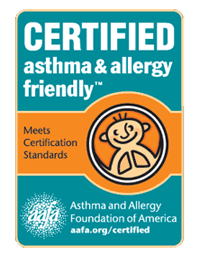Humidity is the amount of water vapor in the air. Too much or too little humidity can contribute to asthma, allergies, skin conditions, infections, and general discomfort.
When there is a lot of water vapor in the air (high humidity), it feels hot and sticky. Sweat has trouble evaporating. When humidity is low, the air feels dry and cool. Sweat evaporates easily.
The amount of actual water vapor in the air is called relative humidity. It is stated as a percentage. The Environmental Protection Agency (EPA) recommends that indoor humidity be in the range of 30 to 50%. The climate where you live, your home’s air ventilation, and your indoor activities all affect your humidity levels. You can test the humidity in the air of your home with a device called a hygrometer.
Controlling humidity inside your home can contribute to better indoor air quality and health.
 Using CERTIFIED asthma & allergy friendly® products in your home can help you keep indoor humidity at a healthy level.
Using CERTIFIED asthma & allergy friendly® products in your home can help you keep indoor humidity at a healthy level.Learn more about the asthma & allergy friendly® Certification Program by visiting aafa.org/certified.
High humidity causes the air to feel warmer than it actually is. This can cause you to overheat. It also encourages the growth of dust mites and mold. They thrive in high humidity above 50% and can trigger asthma and allergies.
If the relative humidity is too high in your home (above 50%), you can use a dehumidifier to remove moisture from the air. Dehumidifiers pull water from the air and collect it in a tank. The tank needs to be emptied and cleaned often. Air conditioners also remove water from the air. Even using the bathroom fan or the exhaust fan in the kitchen can help.
Low humidity can cause your skin to dry out, as well as your eyes, nose, and lips. It can result in a dry, sore throat, as well as worsen eczema and asthma.
If the humidity levels in your home are too low (less than 30%), you can add moisture by using a humidifier. Humidifiers produce water vapor or steam to introduce moisture into the indoor environment. But you have to clean them often to prevent mold and bacteria in the machine.
Humidifiers and dehumidifiers both play supporting roles in a healthy indoor air environment. Monitoring and controlling the humidity in your home can help you manage your asthma and allergies.

Comments (0)